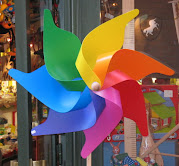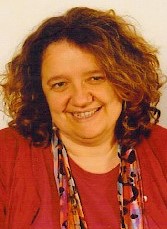
Before lunch we studied and tried to understand the parable of the lost son - including the tension between different meanings of the word "prodigality" - does it mean to be a spendthrift (like the son?) or does it mean to give and not to count the cost (like the father in responding to his son's request?).
Because my feminist theology group had studied this parable a few months ago with Lytta Basset, I dared to ask the young people if they didn't think there was perhaps someone missing from the family - namely a wife or mother. Perhaps she had died or gone away; certainly she didn't seem to be part of the life of the family, or able to influence anyone in it; maybe the menfolk were all shut down in their grief and so unable to communicate with one another?
Later it was very interesting that we all came up with really quite different ways of continuing the story of the parable when each of us wrote possible endings to the story - ranging from deep and real reconciliation between the brothers after a big row, to silence, slamming of doors and the older brother storming off to his bedroom, to a pretend reconciliation followed by a vicious stabbing - echoes of Cain and Abel.
After lunch we asked them to do a communal symbolic picture representing God - based in part on images of God we had developed from the parable. The rules were only one person could draw or paint at time, no comment to be made about what others draw and you can add to what others have already drawn but not obliterate it. My role was to see that the rules were obeyed and then to encourage them to talk about the picture and the process afterwards. We managed it in not quite complete silence as you can imagine.
It was moving to see how from tentative beginnings of a single curvy line on the paper, they gained in confidence and really added to what each one had drawn - sometimes following their own vision and ideas and finding space for that in the bigger picture, but often following on from the flow of what had just been drawn. I realise now that because we made it clear that they would each simply take their turn as it came around the table, this actually gave them more freedom and confidence and meant that those who felt more at home with drawing didn't dominate.
It was powerful but it was also fun. For a long time a whole corner of the paper remained blank then my colleague drew a large question mark in it and immediately the next person added three more dots to represent an unfinished sentence and the next person turned these into exclamation marks. Later the boy in the group who is Franco-Spanish put an upside down question mark within the original one - which of course is how question marks are printed in Spanish, but it perfectly represented ongoing questions within questions.
I was also amazed that very early on someone was willing to break with a flowing peace and love theme that was developing and draw a powerful triangle which then had an eye put into it, looking very much like something you might find over a Baroque altar - later it became a sort of desert island with a palm tree growing out of it. But these are secular, Protestant youngsters who didn't really know what I was talking about when I mentioned it at the end!
The rules said that I was not allowed to add anything, if I had been able to I would have added a rainbow, my favourite biblical symbol. But towards the end someone did add one, perfectly linking two key elements of the drawing, right in the centre and at the top of the picture. It just goes to show, leaders need to let go, wait and trust sometimes.
One of the things I really appreciate about all forms of work with children and young people in the French Reformed Church is that it is not about trying to transmit dogmatic truths but to offer biblical stories and belief in God as something that can help them interpret and make sense of life a little more. When I compare that with much of what I received at church when I was young there's a huge difference. It was hugely liberating to integrate theology into congregational teaching when I started working France.
Anyway we think we may start a KT blog for the parish which will be fun.
Saturday, 8 March 2008
The prodigal son and drawing God at KT
Subscribe to:
Post Comments (Atom)






0 Comments:
Post a Comment